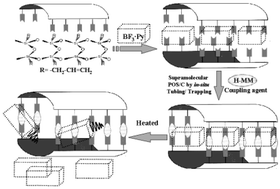A new curing system used for prolonging the shelf-life of epoxy resin-based microelectronic packaging material (E-MPM) was first prepared by an in situ tubing/entrapping method. Based on supramolecular interactions a curing accelerator (C) for epoxy resin, boron trifluoride–pyridine (BF3·Py), has been trapped into the pores of polyorganosiloxane (POS) containing a nanoscale tubular structure, which is prepared by hydrosilylation of two reactive, cis-isotactic ladderlike polyallylsilsesquioxane (Allyl-T) molecules with two reactive, α,ω-coupling agents (1,1,3,3-tetramethyldisiloxane, H-MM) in two plus two (2 + 2) mode using Cp2PtCl2 as catalyst. Various characterizations including optical polarized microscopy (OPM) observations, differential scanning calorimetry (DSC) measurements, storage
and curing tests and molecular mechanical simulation are combined to confirm that the accelerator BF3·Py is simultaneously trapped during the formation of POS and moreover, to indicate that entrapment of the accelerator C with POS is a promising alternative way to prolong the shelf-life of the E-MPM at ambient temperature.

You have access to this article
 Please wait while we load your content...
Something went wrong. Try again?
Please wait while we load your content...
Something went wrong. Try again?


 Please wait while we load your content...
Please wait while we load your content...